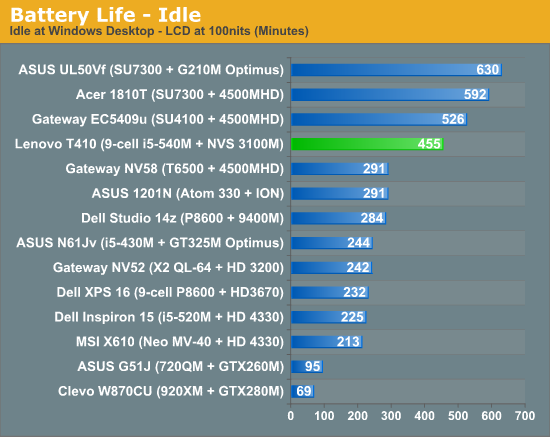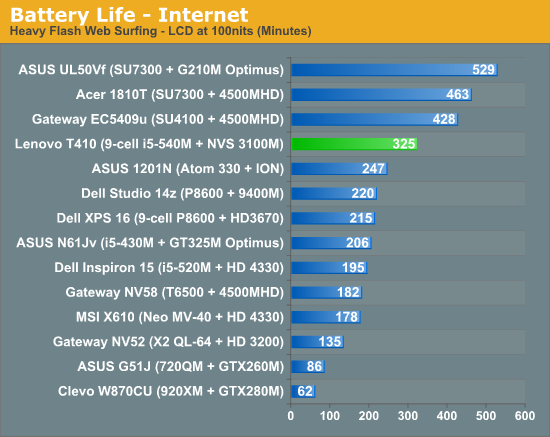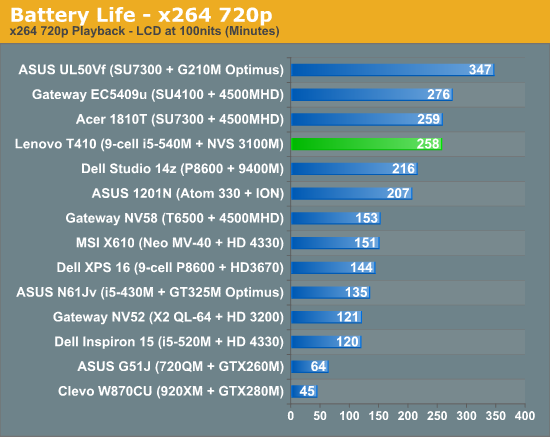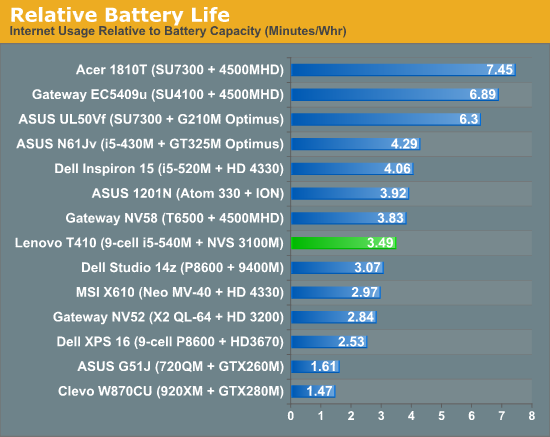Lenovo ThinkPad T410: Built for Business
by Jarred Walton on March 26, 2010 4:00 AM ESTBig Battery = Decent Battery Life
So let's get this out of the way first: the T410 "cheats" by using a 9-cell 94Wh battery compared to 6-cell 48 to 64Wh batteries in competing laptops. The default battery on the T410 is also a 6-cell unit, but if you want more battery life it's nice to have the option of grabbing a higher capacity battery. For a comparison of how the laptops really stack up, look at the relative battery life chart where we factor in battery capacity.




Even with the large battery, it's still clear that the ThinkPad T410 offers very respectable battery life. Lenovo provides some additional utilities that help in this area, with a Power Manager tool that has a "battery stretch" feature. Enable battery stretch and you can have the audio, networking, and optical drive power down. We used the appropriate options during battery life testing (i.e. everything off for the idle test, optical drive disabled on all tests, audio muted except on the x264 playback test, etc.) to provide maximum battery life. We've done the same for other laptops, where possible, so these results are a best-case scenario. Note that we also uninstall and disable any unwanted applications to reduce system demands and improve battery life; if you're running a firewall and anti-virus software, you can expect slightly lower battery life (and of course batteries will degrade over time).
With the 9-cell battery, you can get over four hours of x264 video playback, five hours of web surfing, and 7.5 hours best-case (i.e. idle). We calibrated the LCD for ~100nits and found that a brightness setting of 38% in Windows (or 11/15 with Lenovo's controls) gave us the desired result. Relative battery life puts the T410 in close competition with IGP solutions like the Gateway NV58, but it appears the i5 + HD4330 in the Inspiron 1564 is slightly superior overall. On the other hand, a last-gen laptop like the Dell Studio XPS 16 clearly draws more power from several of the components. The ThinkPad strikes a nice balance between performance and battery life, and getting over five hours of heavy web surfing shows that the T410 with a 9-cell battery will be enough for most business users looking to go all day without recharging.










59 Comments
View All Comments
sgtwiltan - Friday, March 26, 2010 - link
So that means the ThinkPad developers, engineers and people all disappeared when Lenovo bought PCD? Get real! There are guys who worked on the first IBM PC still in the company. AS to the manufacturer on the article being IBM, It should be Lenovo. If it wasn't for Lenovo buying PCD, over 8K American employees would be out of jobs since the American company, IBM decided they no longer wanted us. They should not be getting the credit since the same people who created the the thinkpad line are still making and designing them the same way despite the new ownership. There really should be some kind of IQ test or education requirement to post here. On the other hand it proves this statement." Wise men speak when they have something to say. Fools speak just to say something"
JarredWalton - Friday, March 26, 2010 - link
Sorry about the manufacturer showing as "IBM"... Lenovo wasn't in our list when I added the article, and after adding them I apparently forgot to change from IBM. It's correct now. :-)As for the political "boycott China" stuff, I'll leave the politicking for others. I merely review hardware and I see nothing wrong with Lenovo products compared to the competition. Shame about the LCD being so poor, though; I remember when ThinkPad actually had an IPS panel in a few models!
Belard - Friday, March 26, 2010 - link
We are screw not matter what.Where are the notebooks & desktops of HP, Compaq, Dell, Acer, Gateway (used to be a US Iowa company?) and even SONY and APPLE?
CHINA!
Apple computers, APple iPods and iPhones... all china.
Hard drives, many are from China.
LCD Panels, China
HD TVs... yep, China
If they could/want to infect the hardware, any brand could be effected.
Hell, even our food and toys are from China. :(
There are about 90+ ThinkPad computers on the ISS... so they are every where!
jbwhite99 - Friday, March 26, 2010 - link
That's funny. I own Lenovo stock, and I live in the US. Part of the company (about 20% of it) is owned by the Chinese Academy of Science, but the rest is owned by like IBM, Texas Pacific Group (venture capitalists, etc). It is traded on the HK stock exchange (stock number 0992) or you can buy American Depositary Receipts (LNVGY).I will admit I'm biased, since I work for Lenovo. For the gentlemen that mentioned the rubber paint, the reason that is on the outside is to allow you to grab your notebook. Grab a plastic Dell/Hp/Acer, and it can slip from your hands. Grab a TP, and it won't slip.
Power bricks - every company changed. Lenovo/IBM used 16v standard from 1998 to 2005/6 - then moved to 20v. All machines now use 20v - as do Dell, etc. The difference is that most every Thinkpad will allow you to use the same AC adapter. Netbook (40w) and W700 (170-230w) are a little different, but the rest will run fine.
Belard - Sunday, March 28, 2010 - link
Thanks for the info about Lenovo. While I would prefer it to be more of an American company, if IBM kept making ThinkPads - they'd most likely be out of business by now.Lenovo did bring the price down so I was able to pick up the R61 for $600 with XP at a store surrounded by faster hardware notebooks with vista. I now run Win7 on my R61, it totally rocks.
Oh, that makes sense about the rubber... just wish it didn't attract fingerprints.
Power bricks: yes, they have to change very now and then, but its great that other than the W series & netbooks - the power brick is the same. At my main office and myself, being all ThinkPad - we do sometimes share, swap the power bricks for what is handy. Even the Docking station uses the same exact brick. COOL!
I do wish that Lenovo wouldn't make anything cheaper than the IdeaPad, I think the Econo models look like cheap Compaq and the prices are not much cheaper than IdeaPads which appeal to the Mac / consumer crowd. I almost bought an IdeaPad, but the screen & XP sold me on the R61.
The latest Y models are very cool looking... even the bottom cooling vents have syle.
hko45 - Friday, March 26, 2010 - link
And you think the "Chinese Academy of Science" is just that?In today's world economy, we "vote" with our dollars (and you case, your hours). You've obviously cast your votes. I've cast mine.
hko45 - Friday, March 26, 2010 - link
Got to start somewhere.Can't untangle the components' sources -- true. But we can at least start with the brands. Boycott Lenovo -- for our own self interests.
Any other companies owned by the mainland Chinese government or headquartered in mainland China that should be included on this list?
amosbatto - Sunday, April 11, 2010 - link
I am actually very concerned about the Chinese ownership of Lenovo, since the Chinese government is well known for repressing worker's rights and destroying independent labor organizing. However, I have investigated this issue, and I am not convinced that boycotting Lenovo makes much of a statement.First of all, 92% of all laptops are manufactured by Taiwanese companies. Most of the market is dominated by the big 5: Quanta, Compal, Wistron, Inventec, Pegatron. There are about 10 smaller Taiwanese companies that make the rest. Just about every major laptop brand, subcontracts to these Taiwanese companies to fabricate their laptops. In most cases, the Taiwanese companies are the Original Design Manufacturers (ODMs), which means that they actually design the laptops. In the case of big brands like HP and Dell, they design the laptops in Taiwan, constantly consulting with the engineers from the branding companies. In some cases, the major brands, like Lenovo, Toshiba and Apple, still do some original design of their products, but they turn the fabrication over to one of the 5 major Taiwanese OEMs/ODMs. There are very slim margins in the fabrication business, so many of the OEMs/ODMs try to move into the branding business as well, since most of the profits lay in the final sale. Lenovo, Acer, and Asus have all followed this route, generally spinning their manufacturing arms off into a separate company, such as Wistron and Pegatron.
Now, here is the bad part, almost all those Taiwanese companies, then manufacture their laptops in the lower Yangtse Valley. Something like 95% of the world's laptops are manufactured in the same place, where there is horrible exploitation of labor. Many of the workers are young, unmarried women from the Chinese countryside and they work under extremely exploitive conditions. In recent years, there has been a great deal of labor unrest as these workers have begun to protest their working conditions. Although the Chinese government recently raised wages for the workers, it generally favors the companies and helps to repress the workers. Lenovo used to operate just like the other Taiwanese OEMs/ODMs, owning factories in the lower Yangtse Valley, but now it has started to move away from fabrication and has started turning fabrication over to the Taiwanese firms.
At the end of the day, it doesn't matter whether you are buying Lenovo or Dell, you are still contributing to the exploitation of workers and helping to deny people their human and labor rights. As for supporting US workers, Lenovo uses the old IBM support staff, so it probably doesn't making any difference either. The only way that it does make a difference is that some of Lenovo is owned by the Chinese government, so if you want to stop profits from flowing to the Chinese government, don't buy Lenovo products.
I care deeply about workers rights, but in the end I bought a Thinkpad SL300, after a great deal of study. Why? Most of the environmental damage caused by a laptop lies in its fabrication. Something like 80% of the total energy of a home computer lies in its fabrication according to a 2005 study by Eric Williams. Most the environmental damage in terms of resource use is caused by fabrication, and very little of those resources can be recovered by recycling--around 10% at best, because the fabrication of print circuit boards and silicon chips lays on hundreds of layers of chemicals and materials, which are lost during fabrication and can not be recovered afterwards. Therefore, the most environmental option is to buy a computer which will last as long as possible and not force you to upgrade or replace it. I determined that Thinkpads were probably the best models, which were least likely to fail, and if they do fail, replacement parts can be ordered directly from the Lenovo web site. In the long run, they will probably have the lowest environmental impact, because they don't need to be replaced very often.
Belard - Friday, March 26, 2010 - link
As a ThinkPad owner and someone who does help other people buy notebooks, usually ThinkPads. They are very nice to work with.When I finally bought my first and only ThinkPad for myself, it was the screen that finalized my purchase choice. The store had ThinkPads next to other computers. And not having that HORRIBLE glossy screen is enough.
The glossy "feature" is what adds to the higher contrast levels on all the other notebook screens. Yes, the colors are stronger and the black is richer... makes for watching movies even better.
But for BUSINESS or serious work, we DON'T WANT TO LOOK AT OUR FACES!
And any kind of back ground movement, like in a coffee shop means having constant moving reflections.
I own a bottom end ThinkPad, it does what I need. It came with XP as vista was too horrible to touch. Its now running Windows7Pro and its great. My clients also got ThinkPads with XP pre-installed rather than Vista. Most are also now on Win7.
By working with various models, I have noticed that some ThinkPad screens are better than others. Basic T-series screens are the most bland - odd. My R-Series is nicer. The T-4x0s are actually a totally different unit, its much thinner and costs about $1300~2000.
The SL-Series gives people many ThinkPad features but a modern-looking notebook. It doesn't have the keyboard light. For a dual core, these start out at $600 and are an excellent value.
The features you get from ThinkPads.
- NO Junkware like what comes with HP, Acer, etc. They do include their own TOOLS which are very nice under Windows7.
- MATTE screens... standard. That alone is enough.
- liquid pass through. They have 2~4 drain channels which means spilling your drink will most likely NOT hurt your computer. An HP, Dell, Acer... they are toast.
- 14" models have a complete crash cage, even behind the LCD screen. The 15" models are in the body only. Take one apart and you'll see internal structure that keeps ThinkPads ridged.
- The HDs are in a rubberized caged. Included software detects if the notebook is falling and will shut down the drive.
- Red joy-stick still in the middle of the keyboard, but they have the track-pads of other modern thinkpads.
- Same standard PSUs on their notebooks, after all these years. Far tougher than HPs and most others. Small too.
- Tech support: about the best there is. You can usually talk to a HUMAN in minutes. I've got my nightmares with HP and Dell, they want names, codes, phone numbers. Ugh. I've called them more than once on the phone to ask tech questions while at a retail store. Think Dell does that?
- Lenovo still continues to support older IBM ThinkPads with drivers and tech notes.
- You can order ThinkPAd and they usually ship within 5~8 days (4 times for my clients - wow).
- You can order ThinkPADs with beefed up internal Wifi antennas which make a HUGE difference in 2-story big homes. Also, can include an at&t or Verizon or Clear WLAN cards - so cards with antennas sticking out the side of the computer. Worth it!
I'll admit, I actually don't like the rubberized coating they put on the LCD tops. It fells good, but gets dirty easy and wears off with age. But many ThinkPad fan-boys view the aging like a warrior. (whatever)
The R-Series uses plain plastic. The SL-Series uses really nice textured plastic which I really like and would like to see on their other models, at least as an option.
Put an SSD in a Thinkpad, Windows7 boots in about 8~10 seconds, very very nice.
I love my ThinkPad. :) Apple ibooks are very nice... in looks, the keyboards suck and SONY and HP have copied their flat keyboards.
I just worked on a friends 5 year old $2400 Sony notebook, its pure plastic junk on the inside. Bad layout and cooling. A few months before, I used a very old ThinkPad from 2000 a PIII with Win98. I upgraded the unit to WindowsXP. It had lots of wear on the unit, but it WORKED beautifully, still stiff and reliable. (I wouldn't say todays ThinkPads are quite as tough thou. We want them lighter and cheaper)
I think the ThinkPAD SL is a great $600~900. Its very modern looking with many features that makes it a ThinkPAD. Some old school Thinkpad owners don't like it because its stylish.
erple2 - Friday, March 26, 2010 - link
You need to compare the ThinkPad (Lenovo's business line) with the business line of other companies (like HP, Dell, etc) at the same price/capabilities point. I've spilled several liquids (granted, mostly just water) on my keyboard of the Elitebook I've gotten from work, and they drain out as they should. No damage (that I can tell) from the spill. The drive cage also has a pretty good protection built in.I have never compared the Ideapad (more consumer-driven) line to other business notebooks of other manufacturers, so I can't make those comparisons. Though a quick glance over the Ideapad website shows lots of glossy screened consumer glitzy features that I also don't like on other consumer based laptops.